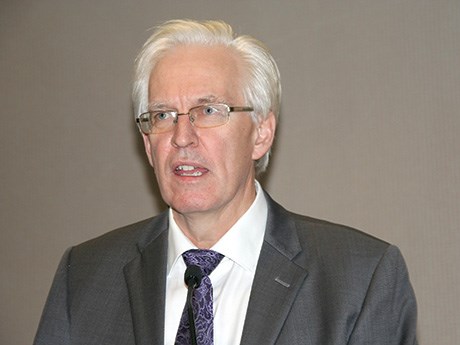Mike MacFarlane, a former Vale and Anglo Gold Ashanti executive with 35 years of experience in the mining industry, warned a room full of mining suppliers at a CAMESE forum on innovation in November that “we’re all going to have to start doing things differently or we’re not going to survive.”
The financial performance of a mine or a mining company is driven by four macro technical indicators, all of which are heading in the wrong direction, said MacFarlane. Labour productivity is going down as we go deeper, energy costs are going up, advance rates are at an all-time low and capital intensity, or capital expense per ounce, is going up.
Using the example of a 3,000-tonne-per-day mine with 300 people, 100 pieces of equipment and a cost per tonne of $100, MacFarlane said the industry needs to target a new technology paradigm that will allow for the operation of the same mine with 50 people, 20 pieces of equipment and a cost per tonne of $30.
“This is really what we have to be thinking about – not an incremental improvement.”
MacFarlane, who served as executive vice-president, business solutions, with Anglo-Gold Ashanti, and director of mining and milling with Vale, took issue with the current focus on automation, arguing the industry needs to first move to continuous mining technology.
“We hear all this chatter about automation, but we’re not continuous yet. We need to be continuous first.
“We’ve taken our inspiration from manufacturing and we’ve tried to do the same thing. We have achieved some success with telerobotics, but the speed we’ve gained has not even been fast enough to tread water when you consider the grades are going down and we’re going deeper. I don’t believe this is the answer and there’s a lot of money being spent in this area.”
According to MacFarlane, “the idea of drill and blast, and economies of scale has run its course. Economies of scale served us well in the 50s, 60s, 70s and 80s, but today it doesn’t work with declining grades and going deeper.”
Mechanical cutting, challenging as it is with the hardness of the rock in the Canadian Shield, would be one way to get to continuous mining, said MacFarlane, citing the possibility of using lasers to weaken 200 to 250 MPa rock down to 100 to 150 MPa.
Haggloaders and rail-veyors can also play a role in enabling continuous mining and are tested and proven technology waiting to be deployed.
MacFarlane pointed to Sweden’s Boliden Group as an example of a mining company that is leading the way in technology and innovation.
“Boliden’s stock price has doubled in the last 12 months,” he observed.
“BHP Billiton’s is down 50 per cent in the same period. Boliden clearly sees technology and innovation as being strategic. The executives are managing it, whereas during my entire career in the Canadian mining industry, a lot of the mining technology was considered tactical and was delegated deep into the organization. You just buy the orange one or the yellow one. That was the choice.”
Boliden, he said, has “world-beating labour productivity and pretty average mines. This is a company to learn from.”
MacFarlane also sees an opportunity to improve the economics of open pit operations by decreasing the amount of waste mines are sending to the mill.
The current practice “is to scoop up everything and send it to the mill,” he complained. “We’re very efficient at sending rock to the mill, but mill costs have gone through the roof. We need to go back to the fundamentals of mining, understand the resource better and aim to send zero waste to the mill.”
MacFarlane urges the mining industry to take charge of its own R&D.
“Equipment suppliers have consolidated into two main companies: Sandvik and Atlas Copco. They’re making a lot of money off the mining industry and the mining industry isn’t making any. This is a major problem. We have handed our R&D over to two companies and, as you would expect, their rational self-interest has taken over. They’re not working for the mining industry – I say that a bit harshly. I probably don’t need to be as harsh as that – but they’re optimizing their business for their own shareholders, and it’s at the expense, I think, of the mining industry.
However, he continued, “mining companies only have to look in the mirror because we have delegated it to them. We need to take it back. If we took it back and managed it, they would be our strategic partners and we would both benefit.”
Advance rates have gone down for a variety of reasons, but we have more million-dollar pieces of equipment as part of the development cycle. “We need to interrupt that trend,” said MacFarlane.
The fate of the industry, he said, is in the hands of the next generation of mining engineers, who “will look at people like me and say, ‘It’s time to step aside. We have a vision for the future and you’re in the way.’”
Either that or “the likes of Google or Elon Musk will turn their attention to the mining industry, in which case we would see disruptive change happen virtually overnight.”


